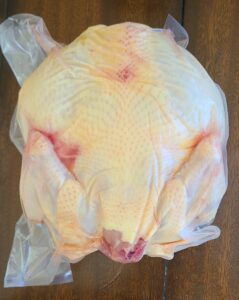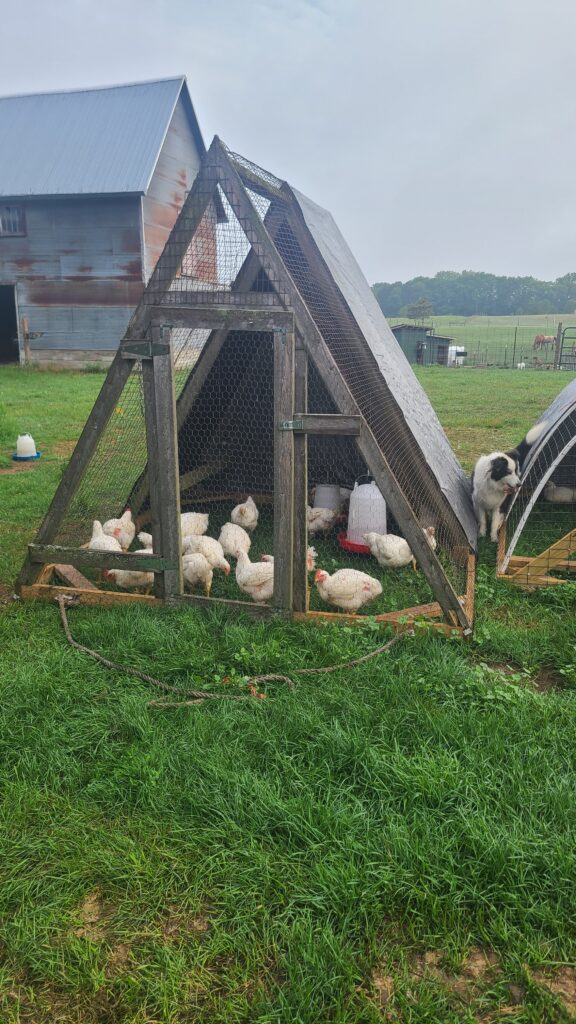Raising meat chickens in your backyard is easier than you might think. In this guide, learn how to take Cornish-Cross chicks and turn them into chicken for your freezer in just eight short weeks. A timeline for housing, feeding, care, and butchering is provided and discussed.

This post contains affiliate links. As an Amazon Associate, I earn from qualifying purchases.
Everybody loves chicken! That’s why we started raising our own meat birds. They are a relatively quick and easy animal to care for and the meat is tender, delicious, and way better than what you can buy at the grocery store.
You can raise a few and use them to feed your family, or raise more than you need and feed your community. On our farm, we raise larger quantities and sell the extra birds to cover the feed costs for the ones that go in our freezer. Essentially, it makes our meat “free” and generates a small amount of income as well.
Read on to learn the process that we use to raise our meat chickens in just eight weeks.
Choosing a Meat Bird Breed
When it comes to selecting a type of meat chicken to raise, you really only have three options. You can choose from the Cornish-Cross, Red Ranger, or a dual-purpose breed.
There are pros and cons to each, we choose to raise Cornish-Cross broilers because they grow very quickly and have the highest carcass yield of any other chicken.
For more information on and even more reasons we love this breed, click here to read 7 reasons to raise Cornish-Cross meat chickens!
Ordering Your Meat Birds
You can get your meat chicks at a farm or feed store or you can order them directly from a hatchery. If you order them from a hatchery, be prepared to pick up your fluffy, chirping box at the post office.
You can choose to purchase straight-run birds (males and females), or, for a higher price, sexed chicks. The benefit of buying sexed cockerels (roosters/ male chickens) is that they will produce a larger, heavier carcasses than hens of the same age.
Preparing a Brooder
Before your chicks are delivered, make sure you have a brooder set up and ready for them. For all you need to know about setting up a brooder for chicks, click here to read my other article!
Moving to a Chicken Tractor
We live in southwest Michigan and raise our first batch of chicks in early April. We wait until the chicks have most of their feathers and can withstand the temperature fluctuations that come with nightfall or changing weather patterns before they go outside. Typically, our chicks stay in the brooder for 3-4 weeks, then they move out to pasture in a chicken tractor.
Chicken tractors are portable coops that provide your meat birds with insects, grasses, worms, exercise, shelter, and safety. For more information on why a chicken tractor is the way to go, click here to read my other article!

Feeding and Care Schedule for Meat Chickens
Here is what you came for! Below is the schedule we use for feeding and caring for our meat birds for the 8 weeks that we have them.
You will notice that we feed our meat chickens a custom-milled, non-GMO, 21% protein starter/grower feed for the duration of their lives. Another option is to use a high protein starter feed and switch to a lower protein grower feed for the last two weeks.
For the first week, we provide the chicks 24-hour access to their feed. After that, we put the feed out at 7:00 am and remove it at 7:00 pm to prevent the Cornish-Crosses from overeating, growing too fast, and the complications that come with.
You will also see that, as previously mentioned, we move the chicks from the brooder to a chicken tractor at between 3 and 4 weeks of age, depending on the weather.
Once the chicks are in their tractor, we move it to new pasture once a day until they reach 6 weeks old. At this point they create enough feces in a 12-hour period, that it is necessary to move them twice daily to provide sanitary conditions and fresh pasture for their consumption.
| Week | Housing | Feed | Care |
| 1 | Brooder | 21% starter/grower 24-hour access | Add bedding as needed |
| 2-3 | Brooder | 21% starter/grower 12 hours on feed, 12 hours off feed | Add bedding as needed |
| 4-5 | Chicken tractor | 21% starter/grower 12 hours on feed, 12 hours off feed | Move to new pasture once daily |
| 6-8 | Chicken tractor | 21% starter/grower 12 hours on feed, 12 hours off feed | Move to new pasture twice daily |
Butchering Meat Chickens
By the end of week 8 your Cornish-Cross roosters will be ready to butcher. Red Rangers and Cornish-Cross hens may need another 2 weeks or more to grow if you want large carcasses.
You can send your chickens to a processor or do it yourself. If you do it yourself, minimally, you will need a boning knife, game shears, scalding pot, and lots of elbow grease for hand plucking. Some other tools that aren’t completely necessary but make the job quicker and easier are a killing cone, mechanical chicken plucker, and additional knives.
You can process your chickens whole, or piece them out. We recommend vacuum-sealing, instead of just wrapping in plastic or freezer paper, because it keeps the meat fresh much longer.
As you can see, becoming more self-sufficient by raising your own chickens for meat is pretty simple. You will experience the pride and satisfaction of knowing where your meat came from and how it was raised and I’m sure you will taste the difference!

Mother, farmer, author, and teacher by trade… She loves tending to things and watching them grow!
